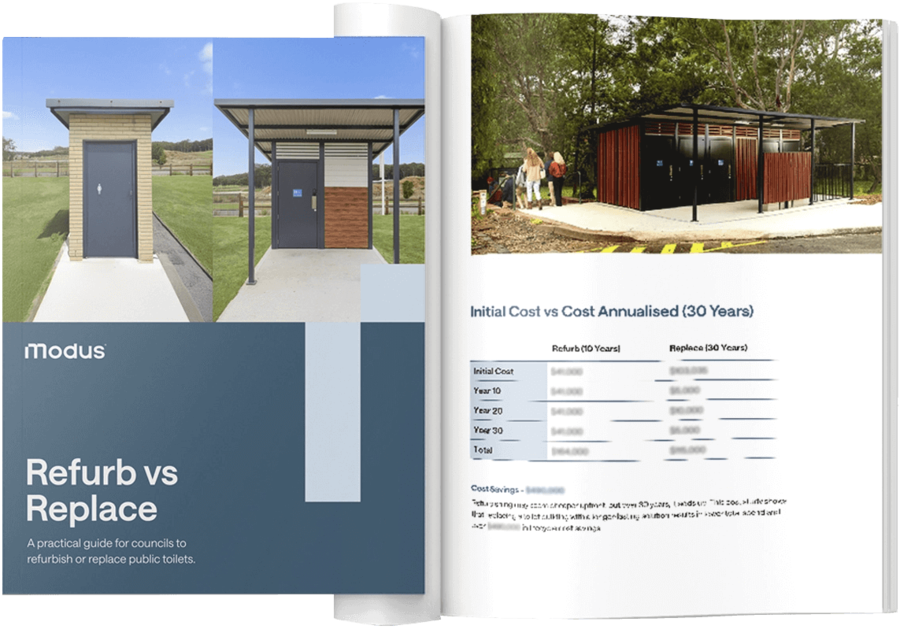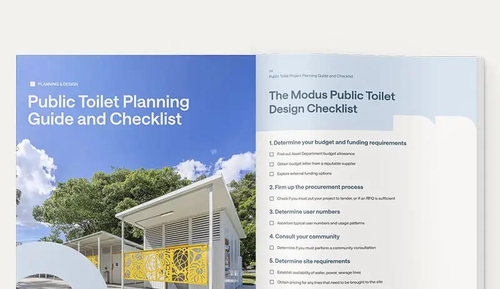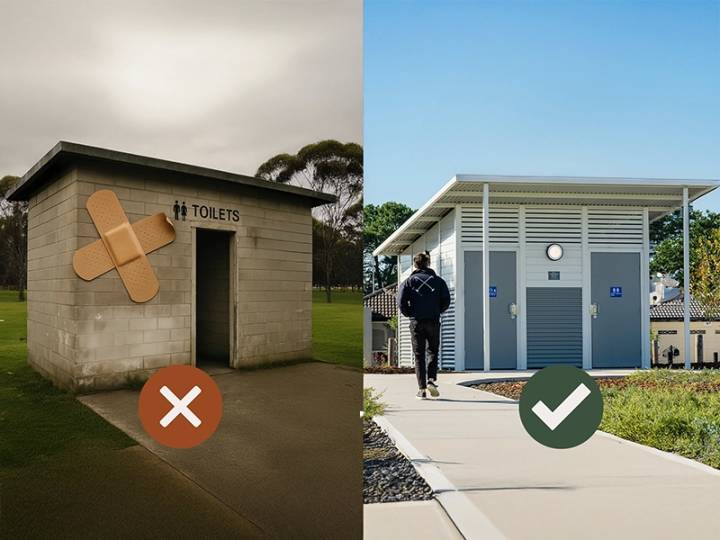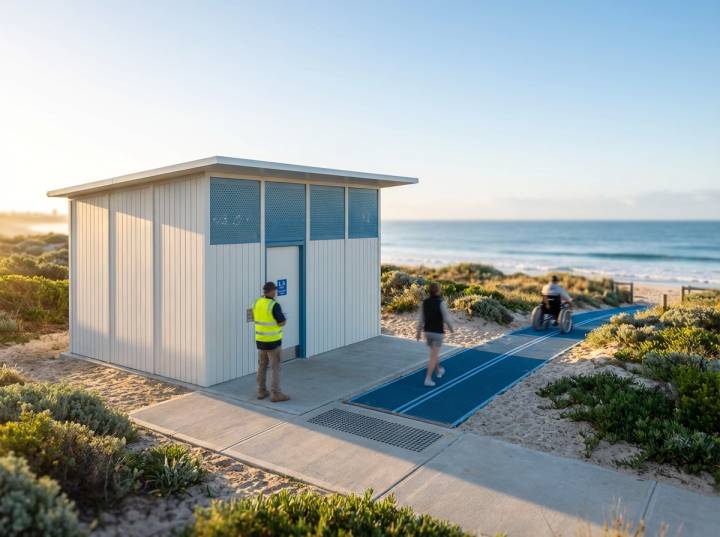Achieving Better Public Toilet Safety with CPTED Design
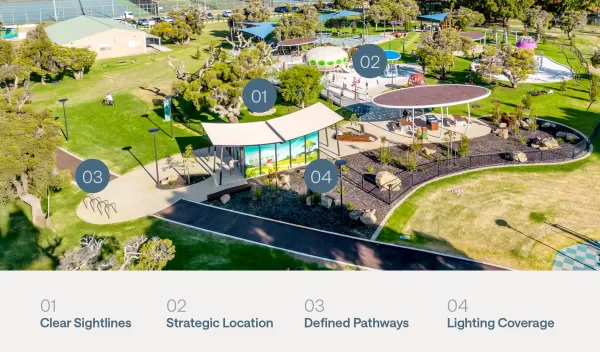
Public toilets — essential civic amenities, yet often plagued by a reputation for being unpleasant, unsafe, magnets for vandalism and anti-social behaviour.
Traditional security responses — heavy locks, barred windows, surveillance cameras — can feel oppressive and fail to address the root causes. The real key to safer, cleaner, and more welcoming facilities isn’t just adding security, but smarter ground-up design.
Enter Crime Prevention Through Environmental Design (CPTED), a proven approach that leverages the built environment itself to deter crime and foster positive use.
Applying CPTED principles specifically to toilet facilities isn't just an upgrade; it's a fundamental shift towards creating spaces that inherently resist misuse and promote community pride. And sometimes, the most economical path forward is ditching the tired, vandalised block anew, using CPTED principles as your foundation.
What is CPTED for public toilets?
Crime Prevention Through Environmental Design (CPTED) is a design strategy aimed at reducing crime and fear of crime by influencing offender decisions. For public toilets, this means creating an environment where legitimate users feel safe and potential offenders feel exposed.
Effective CPTED relies on four key pillars:
- Natural Surveillance: Maximising visibility so users can see and be seen by others in the area.
- Natural Access Control: Using physical design to clearly guide people to entrances and exits.
- Territorial Reinforcement: Distinct design features that express ownership and define public vs. private space.
- Maintenance: Keeping the facility clean and repaired to signal that the area is cared for and monitored.
Why public toilet safety requires a design-led approach
Designing a public toilet comes with a unique challenge: you must provide total privacy for the user while minimising the seclusion that allows anti-social behaviour to thrive. For local government asset managers and landscape architects, balancing these opposing needs is often the hardest part of the process.
Traditional security measures like CCTV or heavy fencing are often reactive. In contrast, CPTED integrates safety into the layout and materials of the building itself. By prioritising visibility, clear access, and robust materials, councils can create facilities that feel safer for the community and are less attractive targets for vandalism.
Applying these principles early reduces the need for expensive security retrofits later. A well-designed facility naturally discourages misuse, ensuring it remains a valuable community asset rather than a maintenance burden.
Understanding the CPTED Pillars for Public Toilets
CPTED rests on four core principles, each offering powerful levers, when it comes to designing or re-designing public toilets:
- Natural Surveillance – The core idea is simple — criminals dislike being watched. Maximising the ability for legitimate users and passersby to see into and around the facility significantly deters undesirable activity.
- Natural Access Control – Strategically guiding how people enter, move through, and exit a space. Clear, defined pathways and entrances/exits located in visible areas make it harder for illicit activities to go unnoticed, and that helps users feel oriented and safe.
- Territorial Reinforcement – Clearly distinguishing between public and private zones within the facility signals ownership and care. It tells users, "This space is valued and managed," discouraging disrespectful behaviour and vandalism.
- Maintenance and Management (the "Broken Windows" Factor) – A well-maintained, clean environment signals active oversight and pride. Prompt repairs and cleaning prevent the perception of neglect, which can invite further crime. This is perhaps the strongest and most visible principle.
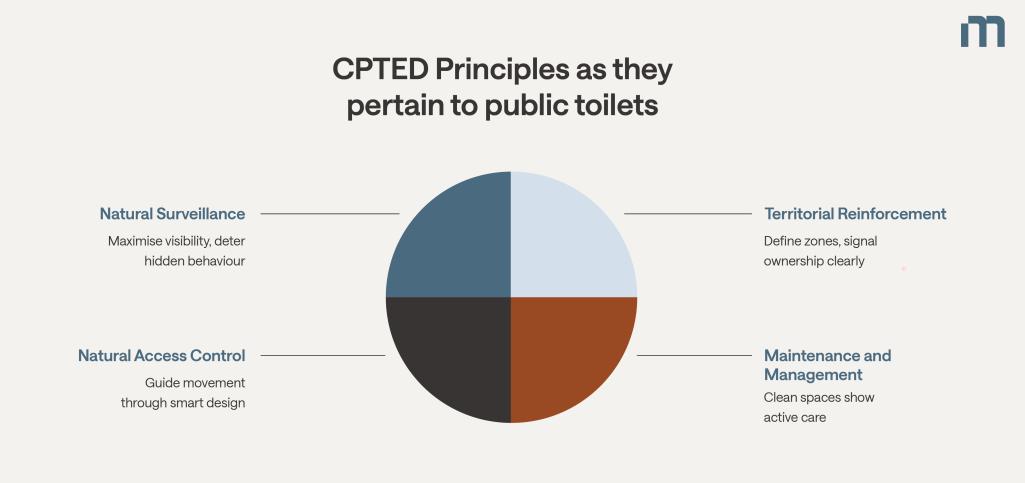
Applying CPTED: Designing Out Toilet Troubles
It’s actually easy to translate these principles that transform a vulnerable toilet block into a resilient and useful community asset.
Supercharging Natural Surveillance
- Integrate Activities – Integrate activities that bring more visibility to the area, such as adding sinks and storage space to maintain hygiene and ease maintenance.
- Maximise Visibility – Use windows, high louvres, and transparent or translucent materials (like frosted glass blocks) for walls facing public areas. Design doors or partitions that don't touch the floor, allowing a view under them into cubicle corridors. Eliminate hidden corners, switchbacks, and deep alcoves where someone could lurk unseen.
- Handwashing Visibility Inside – Position handwashing stations in a semi-open area within the main facility, visible from the entrance but sheltered from the exterior. This maintains passive surveillance benefits while reducing exposure to vandalism.
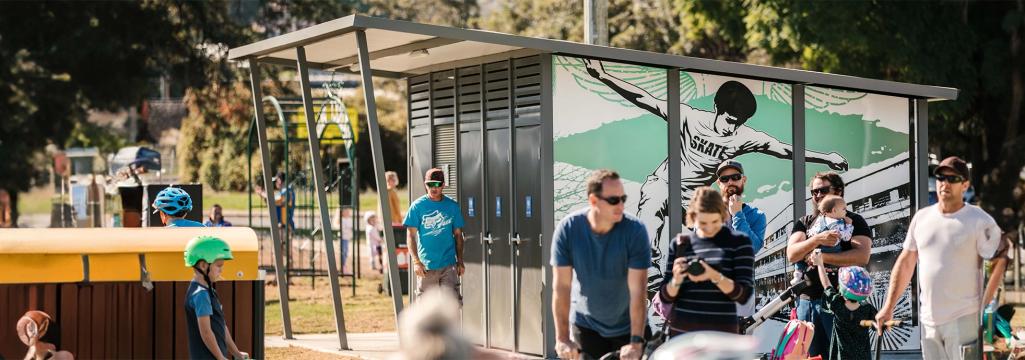
Mastering Natural Access Control
- Location is Paramount – Site toilet facilities in well-travelled areas, close to main pedestrian flows, parks, transport hubs, or retail centres. Isolation breeds vulnerability.
- Clear Entrances and Exits – Position doors so they are clearly visible from major pathways and open outward towards public spaces. Ensure exits lead directly into areas of high traffic, not deserted alleys.
- Simple Layouts – Design straightforward, legible paths. Avoid complex mazes. Users should easily understand the flow from entrance, to cubicles, to sinks, to exit.
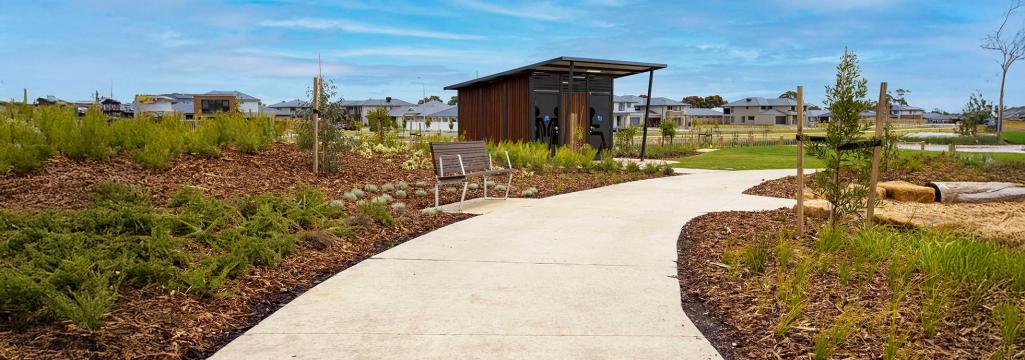
Strengthening Territorial Reinforcement
- Define Zones – Use subtle changes in flooring, ceiling height, or lighting to clearly demarcate the public entrance area, the semi-private sink area, and the private cubicle zone. This reinforces expected behaviour in each space.
- Humanise with Art – Install public art, murals, or quality graphics in and around the facility. This signals community investment and care, making the space feel less institutional and more "owned."
- Clear Signage – Use definitive, easy-to-understand signage for directions, rules, and facility identification. Good signage reduces confusion and reinforces order.
- Quality Finishes – Employ attractive paving, robust fixtures, and well-maintained landscaping. This creates a sense of place and value, discouraging disrespect.
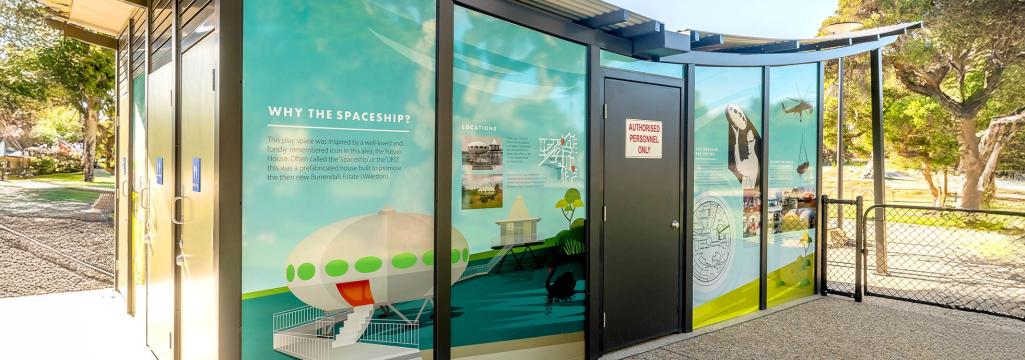
Ensuring Maintenance and Management
- Build for Easy Care – Select robust steel toilets, easy-to-clean, and graffiti-resistant materials (e.g., coated metals, specific concrete finishes, mini-orb cladding that deters tagging). Design gaps under walls for efficient floor cleaning. Use hardy materials that withstand heavy use.
- Zero-Tolerance Upkeep – Implement a rigorous schedule for regular, thorough cleaning of all surfaces, fixtures, and surrounding areas. Remove graffiti and repair vandalism damage as soon as possible, preferably within 24 hours. Consistent maintenance visibly demonstrates control and pride.
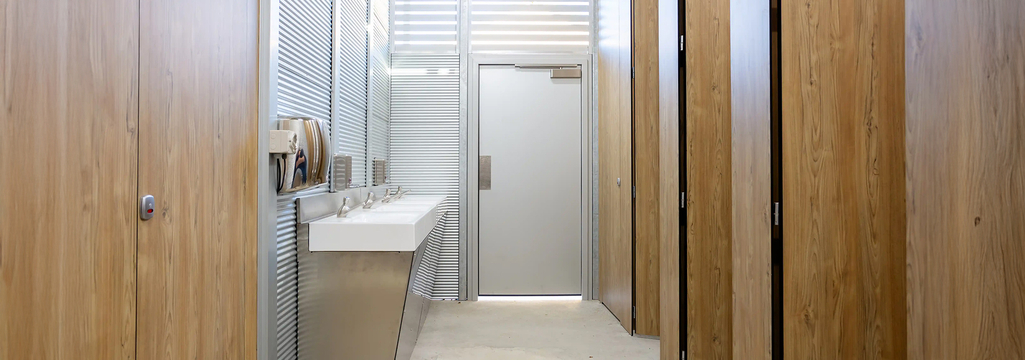
The Economic Case: New Build vs. Retrofit
Often, the most cost-effective solution isn't patching up an old, problem-plagued toilet block, but replacing it entirely with a facility designed from scratch using CPTED principles.
Why?
- Older facilities were rarely designed with security and natural surveillance in mind. They often feature deeply recessed entrances, solid walls, internal corridors with blind corners, poor lighting, and layouts that are fundamentally difficult to supervise. Trying to retrofit surveillance sightlines or radically alter access points into such structures is often structurally complex and prohibitively expensive.
- A new build allows architects to seamlessly design-in CPTED principles. The orientation of the building (facing activity), the placement of windows and doors, the internal flow, the selection of durable, low-maintenance materials, and the integration with surrounding activities can be optimised together. Retrofitting usually means compromising on one principle to address another.
- While the initial outlay for a new toilet facility is higher, the long-term operational costs are typically lower. Reduced vandalism means dramatically lower repair bills. Easier-to-clean designs and durable materials reduce maintenance time and costs. Increased public confidence leads to higher usage and greater community support.
Investing in Safety, Dignity, and Community
Protecting public toilets isn't just about preventing broken fixtures or graffiti; it's about safeguarding essential public health infrastructure and ensuring everyone can access facilities with dignity and without fear. CPTED offers a powerful, human-centered approach. By designing toilets that are naturally in view, clearly defined, easy to manage, and integrated into vibrant public spaces, we create environments where crime and anti-social behaviour struggle to take root.
Poorly designed, neglected facilities invite problems. While retrofitting existing blocks with CPTED elements (like better lighting, removing solid doors, or improving maintenance regimes) can yield benefits, councils and facility managers must seriously consider the compelling economic and practical argument for starting fresh.
Investing in new public toilets built with CPTED principles embedded in their DNA isn't just a capital expense; it's a strategic investment in long-term safety, reduced operational costs, and creating public spaces that truly serve and reflect the pride of the community.
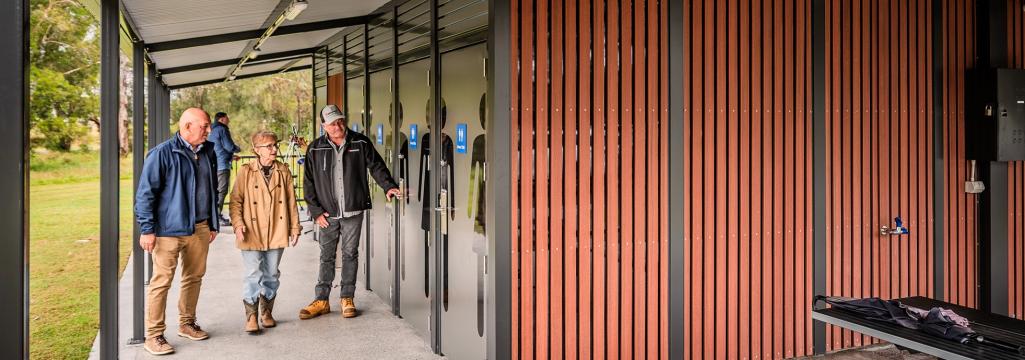
Lismore City Council showcasing new Modus toilet buildings at Wade Park to community members
Frequently Asked Questions
What is CPTED in simple terms?
Crime Prevention Through Environmental Design (CPTED) is a design strategy aimed at reducing crime and fear of crime by influencing offender decisions. For public toilets, this means creating an environment where legitimate users feel safe and potential offenders feel exposed.
Effective CPTED relies on four key pillars:
- Natural Surveillance: Maximising visibility so users can see and be seen by others in the area.
- Natural Access Control: Using physical design to clearly guide people to entrances and exits.
- Territorial Reinforcement: Distinct design features that express ownership and define public vs. private space.
- Maintenance: Keeping the facility clean and repaired to signal that the area is cared for and monitored.
Can we retrofit CPTED principles into an existing toilet block?
Yes. While the most effective results come from the initial architectural design and site selection, many CPTED principles can be applied to existing facilities to improve safety. However, before investing heavily, it is worth comparing the long-term costs of a refurb vs replace strategy. The primary goal of a retrofit is to open up sightlines and remove "entrapment spots" where offenders might hide.
Practical retrofit improvements include:
- Lighting upgrades: Install bright, vandal-resistant LED lighting internally and externally to eliminate dark corners.
- Vegetation management: Prune or remove dense shrubbery that blocks views of the entrance from the street or park.
- Surface treatments: Repaint dark interiors with light, reflective colours to improve visibility and perceived cleanliness.
- Door hardware: Upgrade to robust locking mechanisms and remove handles that can be used as climbing points.
Do we still need cameras and locks if we use CPTED?
CPTED does not replace physical security hardware; it works alongside it. A building designed with strong natural surveillance reduces the reliance on aggressive security measures, but electronic solutions still play a vital role. For example, automated locking systems are essential for managing opening hours effectively without requiring staff attendance.
Cameras are generally restricted to the exterior of public toilets due to privacy laws. However, when a facility is designed using CPTED principles, the exterior approaches are visible and open. This makes any CCTV coverage more effective, as there are fewer blind spots, alcoves, or hidden corners where loitering can occur unnoticed.
Who inside council should be involved in CPTED decisions?
Because public toilets sit at the intersection of open space, community safety, and asset management, CPTED decisions should not be made in a silo. A successful planning process typically involves input from:
- Asset & Facilities Managers: To ensure materials are durable, easy to clean, and affordable to maintain.
- Landscape Architects/Open Space Planners: To site the building correctly for maximum visibility and integration with the park or streetscape.
- Community Safety Officers: To provide local crime stats and specific advice on hot-spot risks in the area.
- Project Managers: To balance these safety requirements with budget and delivery timelines.
Exploring your options with Modus
While these suggestions offer a foundation for action, it’s crucial to recognise that each project is distinct. We are experts in designing toilets with CPTED principles in mind. So, if you’re unsure about the best way forward, call us on 1300 945 930 or book a project consultation below.
